

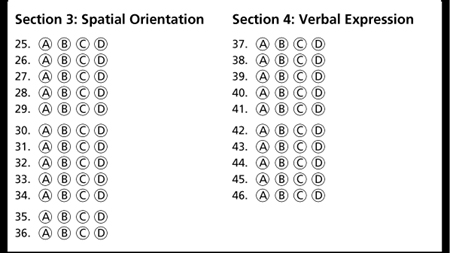
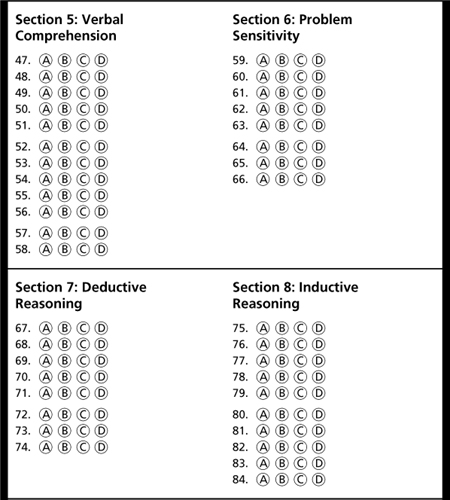
Note: This test has 92 multiple-choice questions. Mark your answers on the answer sheet provided.
Begin by looking at the drawing of the neighborhood scene on the next two pages. You may look at the drawing for five minutes. At the end of the five-minute period, turn the page so that you can no longer see the drawing. Then you will be asked to answer 10 questions about the scene.
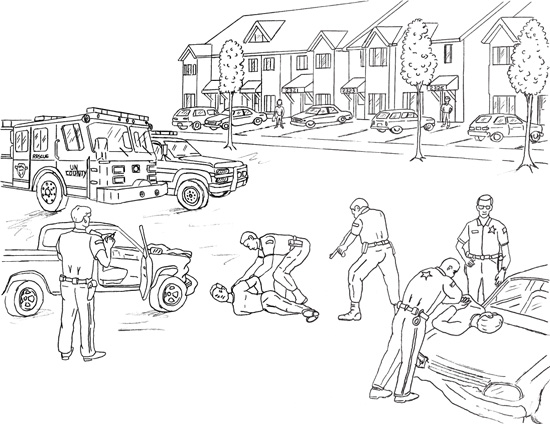
1. How many motor vehicles were parked in front of houses in the scene?
(A) 3
(B) 5
(C) 7
(D) 9
2. How many total law enforcement and emergency vehicles were visible in the scene?
(A) 0
(B) 2
(C) 4
(D) 6
3. How many individuals were under arrest in the scene?
(A) 0
(B) 1
(C) 2
(D) 3
4. What type of vehicles appeared to be involved in a collision?
(A) SUV and van
(B) Van and pickup
(C) Pick-up and sedan
(D) Sedan and SUV
5. What was the lowest house number visible in the scene?
(A) 2202
(B) 2302
(C) 2321
(D) 2324
6. Based upon the clues provided in the scene, what was the name of the street?
(A) Merritt Street
(B) Montgomery Street
(C) Park Street
(D) Tree Avenue
7. How many total law enforcement personnel were visible in the scene?
(A) 3
(B) 5
(C) 7
(D) 9
8. The house numbers were all numbered _______.
(A) Odd
(B) Even
(C) Both odd and even, but non-consecutive
(D) Consecutively
9. How many trees were visible in the scene?
(A) 0
(B) 1
(C) 3
(D) 5
10. How many law enforcement officers had their guns drawn?
(A) 0
(B) 1
(C) 2
(D) 3
STOP. THIS IS THE END OF SECTION 1.
The first face shown, and identified as “suspect,” was drawn based upon descriptions provided by witnesses of crimes. It is believed that the suspect has made an effort to change his/her appearance. Select the lettered face, shown beside the suspect’s face, that most closely resembles the suspect.
11.

12.


14.

15.


Select which of the four lettered vehicles most closely resembles the suspect’s vehicle.
17.
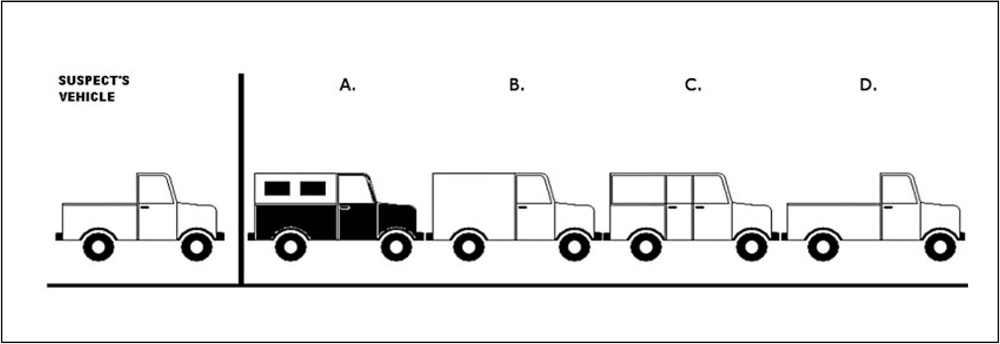
18.
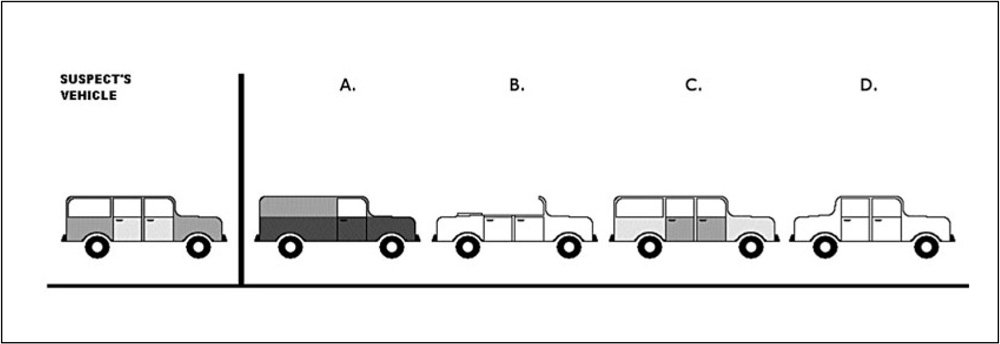

20.

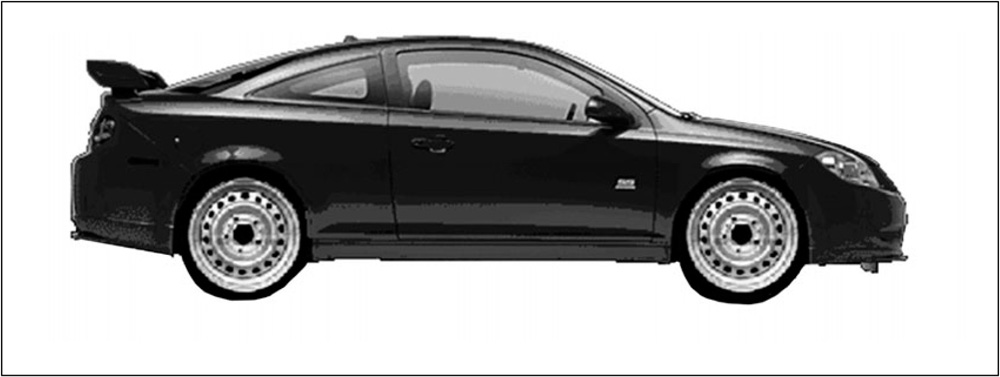
Which one of the following photographs* best matches the tire rims of the vehicle shown in the above photograph?
*Images from WheelShack.com.
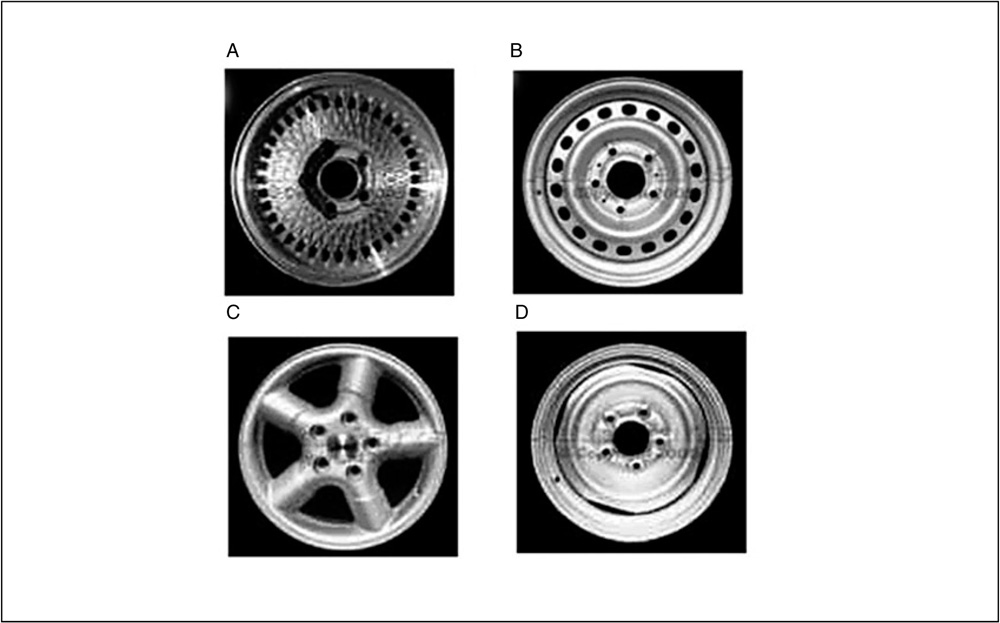
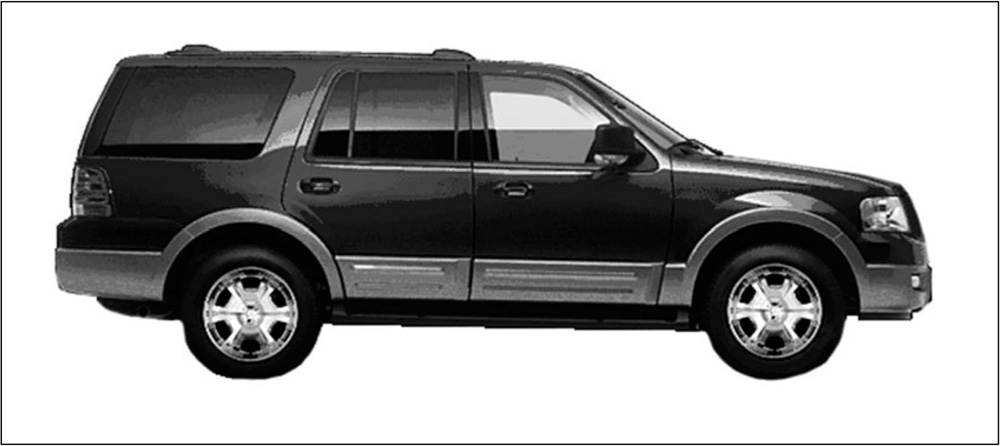
Which one of the following photographs* best matches the tire rims of the vehicle shown in the above photograph?
*Images from WheelShack.com
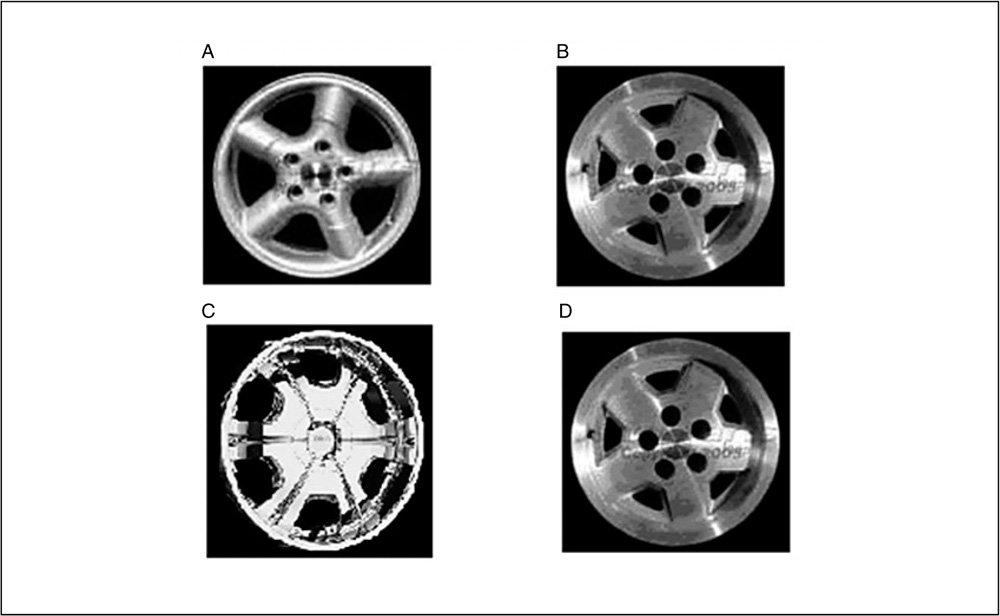
23. Police Officer Johnson follows a perpetrator to a street with the following set of buildings. As he watches the buildings from across the street, Officer Johnson sees the perpetrator run into the fourth building from the right. Officer Johnson notes the shape of the building and runs to the back to try to stop the perpetrator from running out of the back of the building.

When Officer Johnson reaches the alley behind this set of buildings he is too close to count which building he should enter but is able to determine the shapes of the buildings as he passes them. Which building should Officer Johnson watch for the perpetrator?
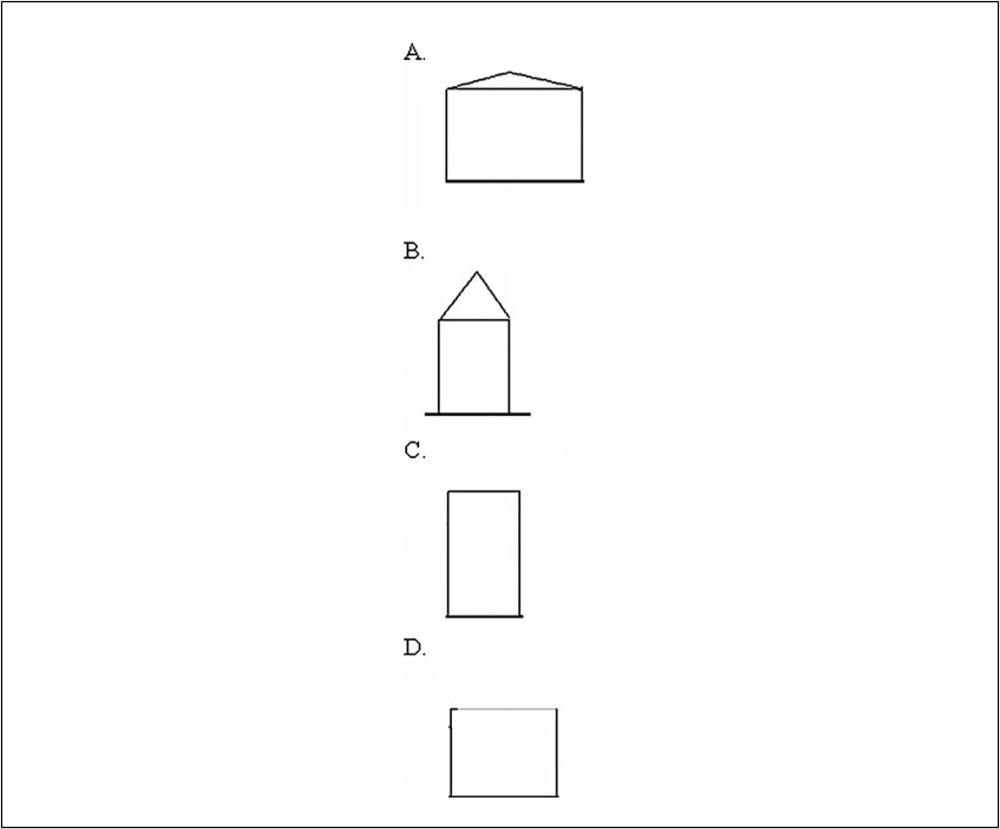
24. Police Officer Johnson is on a beat patrol and passes the following set of buildings:

When Police Officer Johnson walks to the back of this set of buildings, which of the following will best match the buildings as seen from the back?
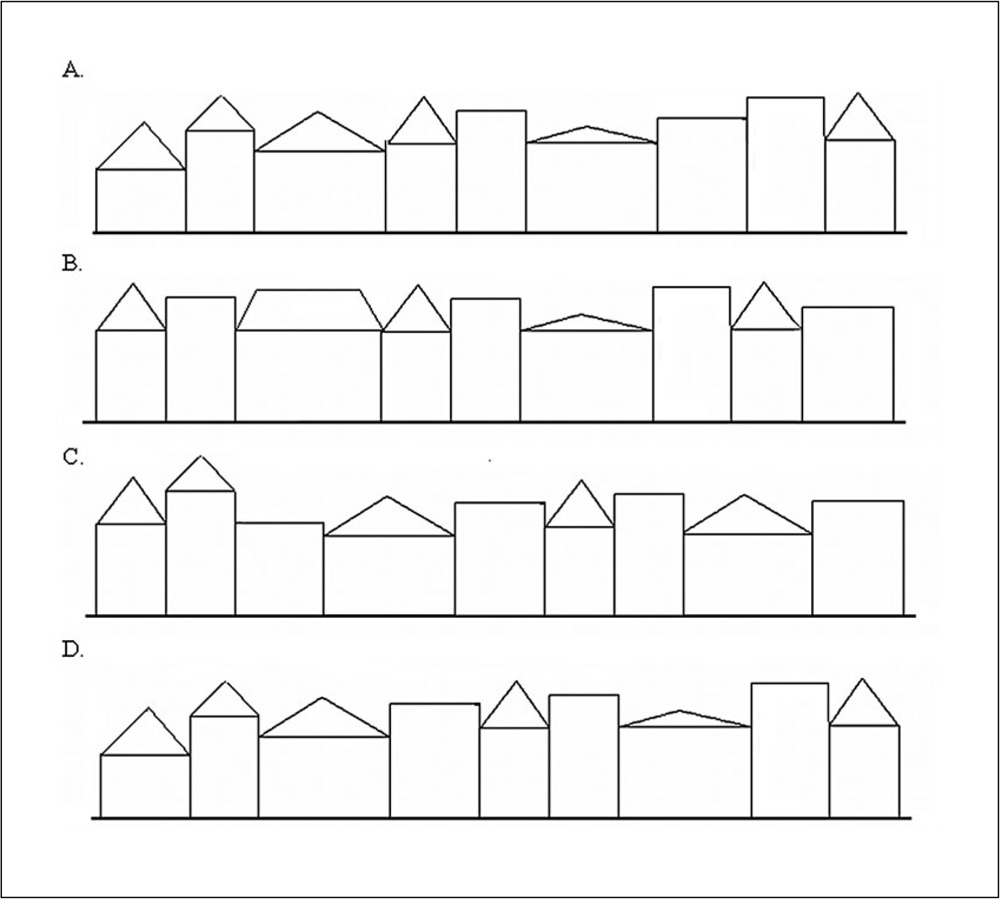
STOP. THIS IS THE END OF SECTION 2.
Answer the following questions utilizing the maps provided.
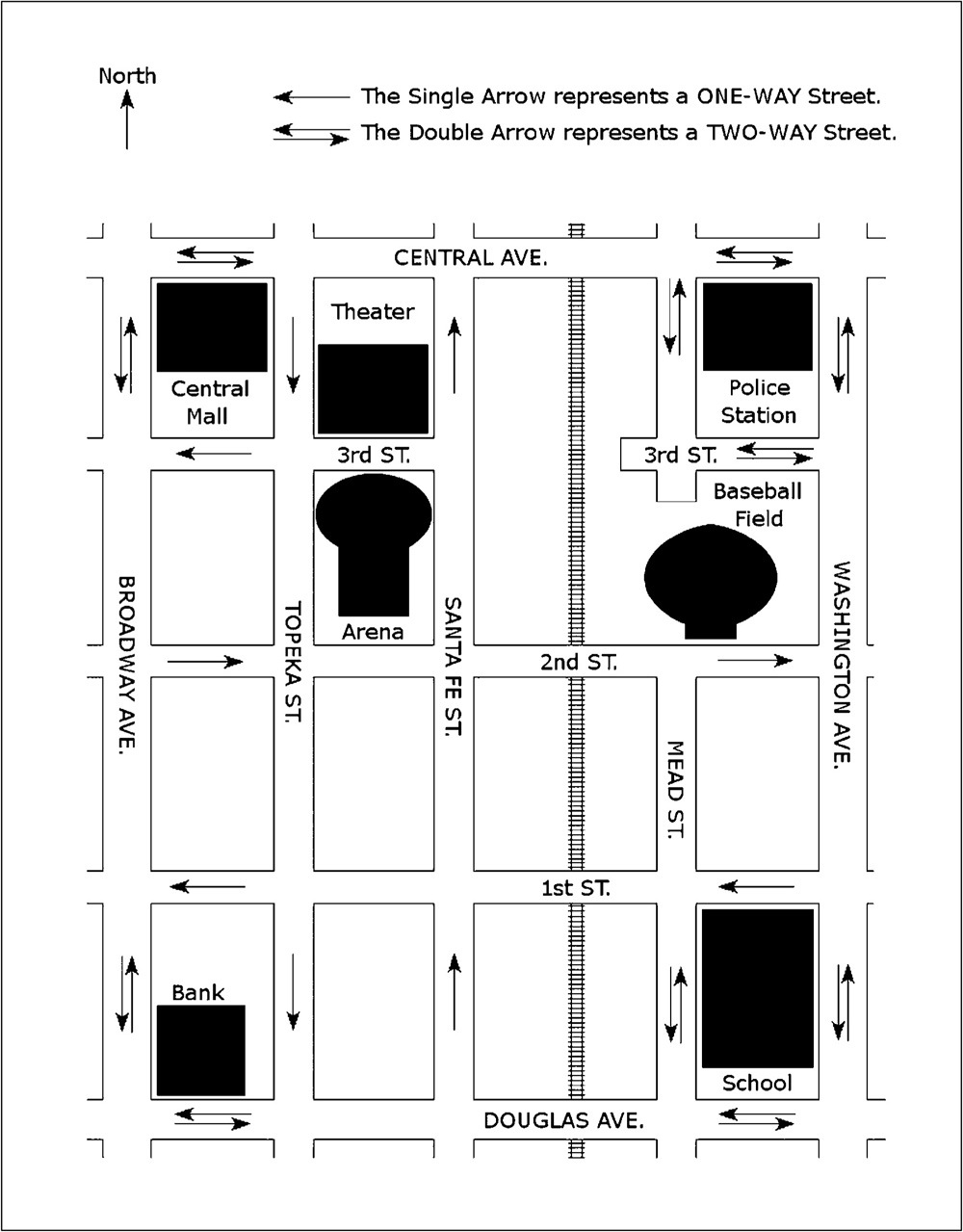
25. You are on patrol at the intersection of Central and Broadway. You are in the middle of a turn to travel south on Broadway when you receive a call to respond to a traffic accident. You continue south two blocks, then east three blocks, and then south one block. When you stop you are at the intersection of:
(A) 2nd and Mead
(B) Mead and Douglas Ave
(C) 1st and Mead
(D) 1st and Santa Fe
26. You are sitting at the intersection of Central and Santa Fe. You are dispatched to 1st and Santa Fe. Which is the most direct route to reach your destination without breaking any traffic laws?
(A) Travel three blocks south on Santa Fe to 1st St.
(B) Travel one block west to Topeka, south four blocks to Douglas Ave, east one block to Santa Fe, and then north one block north to 1st St.
(C) Travel east two blocks to Washington Ave, south four blocks to Douglas Ave, west two blocks to Santa Fe, and then north one block to 1st St.
(D) Travel one block west to Topeka, south three blocks to 1st St., east one block to Santa Fe.
27. You are dispatched from the police station to the Arena, which has parking lot entrances on its southeast and southwest corners. If you are starting from Central and Washington, which is the most direct route to your destination without breaking any traffic laws?
(A) Travel two blocks west on Central, and two blocks south on Santa Fe, and enter the Arena from the southeast corner.
(B) Travel three blocks south on Washington, two blocks west on 1st street, one block north on Santa Fe, and enter the Arena from the southeast corner.
(C) Travel two blocks south on Washington, two blocks west on 2nd St, and enter the Arena from the southeast corner.
(D) Travel three blocks west on Central, two blocks south on Topeka, and enter the Arena from the southwest corner.
28. You are on patrol at the intersection of 3rd St. and Washington. You are continuing to travel south on Washington when you receive a call to respond to a battery. You continue to travel south two blocks, west two blocks, north two blocks, and then west two blocks. When you stop you are at the intersection of:
(A) 3rd and Topeka
(B) 2nd and Broadway
(C) 3rd and Broadway
(D) 3rd and Santa Fe
29. You are on patrol, heading south through the intersection at Central and Broadway, when you see a vehicle matching the description provided in a recent drive-by shooting. You follow the vehicle while waiting for dispatch to respond to your request for information about the vehicle registration. You head south for two blocks, east for three blocks, south for two blocks, east for one block, then north for four blocks, then west for three blocks. You finally receive the information you need and you decide to pull the vehicle over. Where should you tell dispatch to send back-up?
(A) 3rd and Topeka
(B) 2nd and Santa Fe
(C) Central and Topeka
(D) Central and Washington
30. You are on patrol at the intersection of Charles and Eire Avenues. You are in the middle of a turn to travel west on Charles Ave. when you receive a call to respond to a traffic accident. You continue west four blocks, then north one block. When you stop you are at the intersection of:
(A) Redrock and Lorraine
(B) Redrock and Yale
(C) 1st and Volutia
(D) 1st and Charles
31. You are dispatched from the police station to City Hall, which has an entrance at 2nd and Green. If you are starting at Redrock and Eire, which is the most direct route to your destination without breaking any traffic laws?
(A) Travel one block south to Decker, two blocks west to Estelle, one block south to Yale, one block NW on Yale, south one block to 2nd and Green.
(B) Travel west three blocks to Green St, then south two blocks to 2nd and Green.
(C) Travel four blocks south on Eire, three blocks west on Charles St, and two blocks north to 2nd and Green.
(D) Travel three blocks south on Eire, three blocks northwest on Yale, and one block south to 2nd and Green.
32. You are on sitting at a stationary patrol at the corner of Redrock and Yale Avenues. You receive a call to respond to a domestic situation. You start your car and travel southeast two blocks, south one block, and then west two blocks. When you stop you are at the intersection of:
(A) Redrock and Lorraine
(B) Redrock and Yale
(C) 1st and Volutia
(D) 1st and Charles
33. You are on routine traffic patrol, heading north through the intersection at Charles and Volutsia, when you see a vehicle commit a traffic infraction. You activate your lights but the vehicle fails to stop. Then, the vehicle speeds up in an attempt to evade and elude. You carefully follow the vehicle after receiving permission. You travel two blocks north, then one block east, then a short block north, then three blocks southeast, then two blocks north, and two blocks west where the vehicle collides with a street light. Where should you notify dispatch to send assistance?
(A) Red Rock and Yale
(B) Red Rock and Lorraine
(C) Decker and Lorraine
(D) Decker and Estelle
34. Officer Maxwell lives on the NW corner of 5th and McArthur. His address is 197 South 5th Street. He knows the address of the police station is 501 South 5th Street. He is called out to assist at an emergency at 297 South 5th Street. What is the closest intersection to the scene of the emergency?
(A) 5th and Commercial
(B) 5th and Eisenhower
(C) 5th and McArthur
(D) 5th and Fremont
35. You are on routine traffic patrol, heading north through the intersection at 9th and Freedom Drive, when you see a vehicle commit a traffic infraction. You activate your lights but the vehicle fails to stop. Then, the vehicle speeds up in an attempt to evade and elude. You carefully follow the vehicle after receiving permission. You note that you travel two blocks north, then one block east, then three blocks north, then two blocks west where the vehicle attempts to hide by pulling into a driveway and turning off its lights. Where should you notify dispatch to send assistance?
(A) 11th and Freemont
(B) 10th and Freemont
(C) 11th and McArthur Ave
(D) 10th and McArthur Ave
36. You are on patrol at the intersection of 1st and Freedom Avenue. You are proceeding east on Freedom when you receive a call to respond to a traffic accident. You continue east three blocks, then north four blocks, then west six blocks and north one block. When you stop you are at the intersection of:
(A) 3rd and Freemont
(B) 12th and Freemont
(C) 13th and Freemont
(D) 2nd and Freemont.
STOP. THIS IS THE END OF SECTION 3.
Answer the following questions. Some questions will require you to select the sentence that most accurately represents the facts, and other questions will require you to put the sentences into sequential order.
37. A police officer was the first to arrive at the scene of a possible neighborhood disturbance. He observes a large man, standing on top of a car, and hitting it with a sledgehammer. The neighbors are standing around watching, but no one is interfering in the destruction of the vehicle. When the officer’s supervisor arrives at the scene he asks the officer for a brief report. The officer could report the information most correctly by stating:
(A) “The big guy on the car seems to be scaring the rest of these folks. They are too afraid to do anything to stop him.”
(B) “The big guy on the car is out of control. We are going to need back-up.”
(C) “The big guy is hitting the car with a sledge hammer, and the rest of these folks are just watching.”
(D) “The big guy is tearing up someone’s car and he needs to be stopped.”
38. A police officer is dispatched to respond to a report of a foul odor coming from a house. When the officer arrives he is met by a neighbor who has a key to the house from which the odor is emanating. The neighbor explains he only uses the key when the homeowner is on vacation, but he hasn’t seen the man in a few weeks. The officer takes the key, opens the door, and is almost overwhelmed by the strong smell in the house. Upon investigation he finds a man seated in a chair in the living room with an apparent gunshot wound to the head. When the officer’s supervisor arrives at the scene he asks the officer for a brief report. The officer could report the information most correctly by stating:
(A) “We got us a homicide.”
(B) “An adult male was found dead in the house. It looks like he has a gunshot wound in his head.”
(C) “This guy has been dead in there for so long it had to have been a suicide.”
(D) “An adult male was found dead in the house. It looks like he committed suicide.”
39. A police officer is dispatched to respond to a report of a child with a gunshot wound to the abdomen. The officer interviews the father, Mark, and learns these facts. When Mark was cleaning his gun the telephone rang. He left the gun on the table while he went to the adjoining room to answer the phone. Just a few moments later he heard a gunshot and Newton, his son, screamed. When the officer’s supervisor arrives at the scene he asks the officer for a brief report. The officer could report the information most correctly by stating:
(A) “This guy shot his kid and he won’t admit it.”
(B) “This idiot left a loaded gun where a kid could reach it and then walked away.”
(C) “The father reported that he was cleaning his gun. He put the gun down to answer the phone, and then heard a gunshot and his son scream.”
(D) “The father reported that when he was cleaning his gun the phone rang. He put the gun down for just a second while he went to answer the phone. Just a couple seconds after he set down the gun, his son grabbed it and shot himself.”
40. A police officer is dispatched to respond to a report of a vehicle accident. When he arrives he speaks to the driver. The driver said he saw someone on the freeway overpass and then a large rock hit his windshield. The rock shattered his windshield and caused him to lose control of his car. His car is totalled and his family is being transported to the hospital for minor injuries. When the officer’s supervisor arrives at the scene he asks the officer for a brief report. The officer could report the information most correctly by stating:
(A) “The driver of the vehicle lost control of his vehicle and totalled it.”
(B) “The driver of the vehicle claims that someone threw a rock off the overpass and hit his windshield. He lost control of his car, totalled the vehicle, and his family has suffered minor injuries.”
(C) “The driver of the vehicle told me that a rock hit his windshield and shattered it. He thought he saw someone on the overpass just before his windshield was hit. After his windshield was hit he lost control of his car, totalled the vehicle, and his family has suffered minor injuries.”
(D) “This guy is already looking for a way to make some money off this accident. Either someone else threw a rock at his car and caused this wreck, or a rock fell off the overpass and the state is going to be liable.”
41. A police officer is dispatched to respond to a report of a home invasion. When he arrives at the scene he speaks to the homeowner, Darren. Darren tells the officer that he awakened in the night when he heard a noise. He quietly went past the children’s rooms and checked that they were okay. Then he went down the stairs, grabbing a gun from the hall closet. He saw a person in his home that he did not recognize, who appeared to be loaded down by carrying Darren’s television out the door. Darren shot at the intruder but claims he missed. He also admits that he shot at the intruder’s vehicle, a large dark-colored van. When the officer’s supervisor arrives at the scene he asks the officer for a brief report. The officer could report the information most correctly by stating:
(A) “We are looking for a possible gunshot victim. I will notify the hospitals to be on the lookout.”
(B) “The homeowner stated that he shot twice: once at the intruder and once at the intruder’s van. He claims he missed both times.”
(C) “The homeowner stated that he shot at both the intruder and the intruder’s van. He claims he missed the intruder when he shot at him. We should be on alert for a large dark colored van in this area with possible bullet holes.”
(D) “The homeowner claims he shot at an intruder, but he never mentioned where his wife was then, or is now. I think we are looking at a possible murder.”
42. Officer Patterson is preparing an incident report. The report will include the following statements. These statements are not listed in the correct order. Put the sentences into the most logical order.
1. Mrs. Adams explained that she then saw Abe carry the teapot out to the driveway where he handed it to Ben.
2. Mrs. Adams stated that on Thursday evening she saw Abe pick up the silver teapot with her name engraved on it, which she received for her 45th birthday.
3. Mrs. Adams concluded her statement by stating that she is very angry about the loss of her teapot because she had told Abe numerous times to never touch it.
4. Officer Patterson responded when Mrs. Adams called for a police officer to come to her home to take her statement.
5. Mrs. Adams began by stating that her son, Abe, and his friend, Ben, were at her house Thursday evening.
(A) 1, 2, 3, 4, 5
(B) 1, 3, 5, 2, 4
(C) 4, 5, 2, 1, 3
(D) 4, 5, 3, 2, 1
43. Officer Jones is preparing an incident report. The report will include the following statements. These statements are not listed in the correct order. Put the sentences into the most logical order.
1. “Honest Clem” Stephens, a used car dealer, called for police assistance.
2. The couple asked to drive the minivan for a few hours to see how it handled on the highway versus city driving. Because it was a common request “Honest Clem” agreed.
3. A week has passed and the couple has not returned the minivan.
4. Honest Clem told Officer Jones that a nice young couple came in looking for a new car.
5. Honest Clem took the young couple to test drive several different models before they decided on a minivan that they liked.
(A) 1, 2, 3, 4, 5
(B) 1, 4, 5, 2, 3
(C) 4, 3, 2, 1, 5
(D) 4, 5, 3, 2, 1
44. Officer Matthews is preparing an incident report. The report will include the following statements. These statements are not listed in the correct order. Put the sentences into the most logical order.
1. Sam claimed that a new company policy required farmers to give the company title to the cattle being shipped so that the company would have legal right to sell the cattle.
2. Farmer Happy, trusting the company, helped Sam load the cattle, and signed the forms giving Sam title to the cattle in exchange for a verbal agreement that the company would pay Farmer Happy 90 percent of the amount of money that the cattle sold for at market.
3. Farmer Happy contracted with The Transport and Sell Company, a company he had used before to haul his cattle to market and sell them, to pick up 15 head of cattle for transport to market.
4. On the appointed day a semi-truck pulled up in his yard to pick up his cattle, driven by a new driver named Sam.
5. Two hours after Sam left a semi-truck from the company, driven by the driver Happy usually dealt with, showed up claiming to be from the same company, and that driver also claimed he had never heard of Sam.
(A) 1, 2, 3, 4, 5
(B) 3, 4, 1, 2, 5
(C) 4, 3, 2, 1, 5
(D) 3, 5, 4, 2, 1
45. Officer Hussein is preparing an incident report. The report will include the following statements. These statements are not listed in the correct order. Put the sentences into the most logical order.
1. Officer Hussein also found a white male who appeared to be in his late teens in the Johnson’s kitchen, going through the drawers and holding an empty pillowcase.
2. Upon arriving on the scene Officer Hussein found that a large window has been broken.
3. Mr. Johnson and his wife are hiding upstairs in the bedroom closet and are calling from a cellular telephone.
4. Mr. Johnson called police at 2:00 A.M., to request immediate assistance at his home.
5. Mr. Johnson thinks that he hears a prowler in his kitchen.
(A) 4, 5, 3, 2, 1
(B) 3, 4, 1, 2, 5
(C) 4, 3, 2, 1, 5
(D) 3, 5, 4, 2, 1
46. Officer Readrow is preparing an incident report. The report will include the following statements. These statements are not listed in the correct order. Put the sentences into the most logical order.
1. The City has contacted the police to report a theft of utility services.
2. Upon contacting the City, the officer is informed that Krystal Smith is the occupant of the home where the utility services are being used without permission.
3. Krystal agrees to talk to you. She tells you that she can’t afford to purchase all of her utilities.
4. After about twenty minutes, Krystal finally admits that she has figured out how to hook up her water without notifying the city.
5. Before talking with Krystal, you conduct further investigation. You learn that Krystal Smith is 19-years-old, works at T-Quik, and has lived on her own for two years.
(A) 1, 2, 5, 3, 4
(B) 3, 4, 1, 2, 5
(C) 1, 2, 4, 5, 3
(D) 1, 2, 4, 3, 5
STOP. THIS IS THE END OF SECTION 4.
Read each scenario presented and complete the questions.
SCENARIO NO. 1
Typically, officers must have probable cause to believe that an individual is involved in criminal activity before interfering in that person’s right to be free from governmental restraint. However, in limited circumstances an officer may have legal authority to make an investigatory stop. An investigatory stop is an action by law enforcement to interfere with an individual’s right to liberty. This interference must be based upon an officer’s reasonable suspicion that criminal activity is occurring and must be limited to that amount of time necessary to clarify the suspicious behavior.
When making a stop based on reasonable suspicion an officer need only be able to clearly state articulable facts to support his belief that criminal activity is occurring before he interferes in an individual’s right to liberty. Articulable facts are more than a mere hunch. An officer should be ready to clearly list several facts that formed the basis for his belief that criminal activity was occurring.
While executing an investigatory stop, officers must act quickly to either confirm or dispel their suspicions. Courts will always inquire into the length of the detention. If the length of the stop is unreasonable, any evidence obtained from the stop will be suppressed at trial.
Why is the period of detention important? Remember, a stop is an investigatory tool available to law enforcement for actions based on less than probable cause. If a stop lasts too long, it may turn into a de facto arrest. An arrest is only lawful when supported by probable cause to believe that criminal activity is occurring: a standard somewhat higher than reasonable suspicion. Without probable cause to support the stop, the stop becomes an unlawful arrest.
47. According to this article, the length of an investigatory stop is important because:
(A) A long stop will cause a court to inquire.
(B) If a stop lasts too long, it may turn into a de facto arrest.
(C) An investigatory stop interferes with an individual’s right to liberty.
(D) An investigatory stop is a search.
48. A stop is ________.
(A) An interference with a citizen’s liberty.
(B) An illegal act by law enforcement.
(C) A search for actions based on less than probable cause.
(D) A traffic enforcement tool.
49. Generally, before law enforcement arrests an individual, police must have ____________ to believe that a crime is occurring/has occurred and that the individual participated in the crime.
(A) Reasonable suspicion
(B) Probable cause
(C) Beyond a reasonable doubt
(D) Articulable facts.
SCENARIO NO. 2
Officer Jones sees a vehicle he does not recognize parked on the street in a residential district that he regularly patrols. When Officer Jones checks the time he sees that it is 2:05 A.M. Officer Jones notices that an individual is sitting in the vehicle. The occupant appears to be alone. None of the homes in the area have any lights on, and it appears that everyone in the neighborhood is asleep. When Officer Jones slowly drives past the vehicle the occupant quickly lies down in the seat. Officer Jones drives around the block and re-approaches the vehicle from behind. The occupant is now sitting up again and appears to be watching Jones’ patrol car in his rear view window. As Officer Jones parks his vehicle behind the occupied vehicle, the occupant jumps out of his car and starts to run toward an area between two houses. Officer Jones runs after the individual, and shouts at him to “stop!” Although the individual did not respond to Officer Jones, Jones was able to catch him as he attempted to climb over a fence into a backyard.
50. According to the preceding passage, Officer Jones drove past the suspicious vehicle _____ times without stopping before finally stopping to contact the occupant.
(A) 1
(B) 2
(C) 3
(D) 4
51. According to the preceding passage, Officer Jones was suspicious about the vehicle for all of the following reasons EXCEPT which?
(A) Officer Jones sees an occupied vehicle he does not recognize parked on the street in a residential district that he regularly patrols at 2:05 A.M.
(B) Officer Jones notices that the individual is sitting alone in the vehicle.
(C) When Officer Jones slowly drives past the vehicle the occupant quickly lies down in the seat.
(D) As Officer Jones parks his vehicle behind the occupied vehicle, the occupant jumps out of his car and starts to run toward an area between two houses.
52. According to the preceding passage, Officer Jones discovered that _____.
(A) The individual was a teenager who was afraid to go in the house because he had missed curfew.
(B) The individual was a registered sex offender who just needed some alone time.
(C) The individual lived at the house where the car was parked, and was in the car searching for his wallet because he had discovered it was not in his pant’s pocket when he was getting undressed. He had been wrongfully arrested three years earlier and still feared police.
(D) He did not have any information about the occupant of the vehicle or his reason for being in the vehicle in the middle of the night.
SCENARIO NO. 3
Officer Leventhal responds to a report of a battery. Upon arriving at the scene Officer Leventhal speaks with Adam who was involved in the incident. Adam tells Officer Leventhal that he decided to go for a run on the City Park jogging path. He had been mugged the previous month so he was a little nervous. About half way through his run he noticed that someone was following him. He became concerned, but did not leave the jogging path feeling that it was the safest place to be. Soon he could tell by the sound of the pursuer’s footsteps that he was getting closer. Adam reported he was very scared, but determined not to be a victim again. He turned around and punched his pursuer in the face.
53. According to the preceding passage, the only statement that accurately reflects the information known by Officer Leventhal is:
(A) Adam was a victim of a mugging.
(B) Adam hit another runner in the face.
(C) Adam had a right to use self-defense to protect himself against his pursuer.
(D) Adam became very frightened when he believed he was being pursued and hit his pursuer in the face.
54. According to the preceding passage, Adam was nervous to go running because:
(A) He had been attacked in the park a few weeks earlier.
(B) He had been mugged the previous month.
(C) He had been mugged downtown the previous month.
(D) He had been mugged while jogging the previous month.
55. According to the preceding passage, the only fact that police have about Adam’s pursuer was that he:
(A) Raced to catch up with Adam
(B) Was a faster runner than Adam
(C) Was a mugger
(D) Would not have harmed Adam.
SCENARIO NO. 4
Officers Pam and Jornak are called to a report of a homicide at a small sports bar. Barbara, a regular patron of the bar, points out the bartender’s body to the officers. She said that no one had been paying attention to what was going on in the bar until they heard someone scream because everyone was watching a good game on television. She only left her table to get beers from the bar. She didn’t realize anyone was throwing a knife.
Beth, the waitress is also still on the scene. She says that the bartender was killed by Tom Stern, who she points to at a nearby table. Beth tells you that everyone in the bar was yelling at Tom to stop throwing knives because he was going to hurt someone. Tom spent about two hours throwing Bowie knives at the dartboard without incident. Then, he sent a knife flying away from the dartboard. It landed in the bartender’s heart and killed him instantly.
When Officer Jornak talks to Tom he explains that he was at the bar that night playing a game he invented which he calls “Scarier Darts.” The game is very like darts but uses Bowie knives in place of darts. Most nights Tom can get someone else in the bar to play with him, but that evening no one else was interested in playing. However, everyone watched him play and cheered him on. So, he played until he missed the dartboard and the knife hit the bartender.
56. According to the previous passage, which of the following statements most accurately reflects information given to the officers at the scene?
(A) Tom left the scene.
(B) Tom owed the bar a lot of money for damages from throwing knives.
(C) Tom had played his knife game in the bar before.
(D) Tom and the bartender did not get along.
57. You believe it is critical to know whether Tom had been disrupting the rest of the bar patrons by throwing a knife at the dartboard for two hours. Which of the statements was most believable?
(A) Barbara’s statement, because she didn’t work for the bar, had no way of knowing either Tom or the bartender, and wasn’t emotionally involved in what happened there.
(B) Beth’s statement, because Barbara’s statement is so unbelievable.
(C) Beth’s statement, because she admits to being aware of what was happening in the bar and her statement is similar to Tom’s statement.
(D) Tom’s statement, because he has no interest in the outcome of the investigation.
58. Which of the following most accurately reflects what happened based upon the statements provided?
(A) Tom Stern threw a knife and it struck the bartender and killed him.
(B) Tom Stern was dating Barbara, and he was mad at the bartender for asking Barbara out.
(C) Tom Stern accidentally killed the bartender.
(D) Tom Stern was throwing the knife to irritate the waitress.
STOP. THIS IS THE END OF SECTION 5.
Read the information that is provided and then answer questions 59–60.
The Department of Police and Fire have the following standard procedure for first responders arriving at the scene of a fire.
1. Note the time of your arrival. Note the color of the flames in order to assess the intensity of the fire. Also, note the color and odor of the smoke. Keep your patrol vehicle back from the burning structure to avoid explosion.
2. Note the people at the scene, including those near or leaving the scene of the fire. Note any unusual behavior of people at the scene. Evacuate the area or nearby homes if the situation warrants.
3. Note any covered windows or doors. Note whether the covering is shades, blankets, newspapers, or any other method an arsonist might use to delay the discovery of the fire. Do not knock out any windows as the addition of air to the fire could cause it to accelerate.
4. Note whether any obstacles have been placed to hinder access to the building, such as a dumpster or pile of trash placed in front of a door. If doors or windows are already open and away from the area on fire, law enforcement may approach that window/door and call out for possible victims trapped inside.
5. Law enforcement should avoid entering a burning structure, but should note the Fire Department’s method of entry into the building. Note whether any doors were locked or left open. Note whether any doors looked forced open prior to the fire.
59. Officer May is the first responder to a building fire. He notices that he arrived at 9:10 P.M. He notes that the flames coming from the building are yellow-orange in color and that a gasoline odor exists. He then notes that no one is around the scene and that trash cans loaded with rocks have been placed in front of the two doors. Given this information what should Officer May do next?
(A) Back away and take no further action.
(B) Begin a preliminary determination about possible victims without entering the building.
(C) Continue to take notes about the status of the building.
(D) Enter the safest area of the building and look for possible victims.
60. Which of the following actions would be the most potentially dangerous mistake Officer May could make?
(A) Knock out all of the windows in preparation for the Fire Department’s arrival.
(B) Leave the scene to go in search of a fire extinguisher.
(C) Park his patrol vehicle next to the back door to prevent any bystanders from entering the burning structure.
(D) Begin evacuation procedures.
Read the information that is provided below and then answer questions 61–64.
Contact between police and members of the public range from friendly interactions to investigative encounters. The requirements for authorized police contact with a private person vary according to the degree of intrusiveness involved.
1. Consensual contact. No justification is necessary. The officer should exert no authority in the situation and the citizen should understand that they are free to leave and not required to respond. Refusal to give consent to search or to answer questions does not create reasonable suspicion or probable cause.
2. Dog sniff. No justification is necessary. A sniff must be reasonably conducted and the person’s freedom of movement or control of his or her property must not be interfered with.
3. Investigative Stop. Reasonable suspicion. An officer who has specific facts supporting a suspicion that a person is committing, has committed, or is about to commit a crime may stop and detain a person briefly, generally less than ten minutes. The officer may ask for identification, inquire about the person’s suspicious behavior. Once the purpose of the detention is carried out the detainee must be released, unless clear evidence of criminal conduct is discovered.
4. Protective frisk. Reasonable suspicion. An officer may frisk a person if the officer has specific facts supporting a suspicion that the person is armed and a danger to the officer or others. The justification for a frisk may arise in any encounter with a private person.
5. Arrest. Probable cause. An officer has probable cause to arrest if facts and circumstances known to the officer at the time of the arrest justify a reasonable belief that the person has committed or is committing a crime.
61. Officer Lee notices that an unknown male has stopped his vehicle next to another vehicle to talk to a second unknown male. Officer Lee is aware that area residents have been complaining about drug trafficking in the area. Officer Lee does not see any evidence of drugs or money, but he is approximately 200 feet away from the two men. Officer Lee approaches the two men and asks them to pull their vehicles to the side of the road. He then asks to see identification for each driver. When he sees that the addresses listed on both the licenses are for homes just down the street he returns the licenses and tells both men to have a nice day. What type of police/citizen interaction has occurred?
(A) Consensual contact
(B) Investigative stop
(C) Arrest
(D) No interaction
62. Officer Jones conducts a routine traffic stop. The driver of the vehicle is acting very nervous and her hands are shaking. Officer Jones is suspicious of her behavior and asks for permission to search the vehicle. The driver refuses to give her consent. Based on this information, what may Officer Jones do next?
(A) Nothing.
(B) Require the driver to wait 25 minutes for the arrival of a drug-sniffing dog.
(C) Remove the driver from her vehicle and frisk her for weapons.
(D) Arrest the driver on suspicion of drug trafficking.
63. Officer Leon is walking through the mall when he sees two girls racing out of a store clutching their shopping bags to their chests. He sees the store manager yelling at the girls to come back. The correct level of police/citizen interaction at this point is:
(A) Consensual contact
(B) Investigative stop
(C) Arrest
(D) No interaction
64. Officer Lopez approaches an individual he knows is wanted on an active warrant for attempted murder. The correct level of police/citizen interaction at this point is:
(A) Consensual contact
(B) Investigative stop
(C) Arrest
(D) No interaction
Answer questions 65–66 based on the information given in each question.
65. Police Officer Chow interviews four witnesses to a murder, which occurred outside of a carwash. Each of the witnesses was present at the time of the shooting. They described the perpetrator as follows:
Witness No. 1. She had short brown hair, a tattoo on her neck, and baggy shirt jeans. She was barefoot.
Witness No. 2. He was short with brown hair, a loose fitting button up shirt hanging open over a white t-shirt. He had baggy blue jeans on, and raggedy old tennis shoes.
Witness No. 3. She was average height but dressed like a boy. She had brown hair and really tanned skin. She had on a short-sleeved button up shirt over a white t-shirt, and baggy blue jeans. She had a tattoo on her neck, which was clearly visible because her hair was so short.
Witness No. 4. She was average height and was wearing baggy clothes and old tennis shoes. Her hair was pulled up into a bun so a big bruise was visible on her neck.
Based on the descriptions provided, which of the four witness statements is most likely to be correct?
(A) Witness No. 1
(B) Witness No. 2
(C) Witness No. 3
(D) Witness No. 4
66. Police Officer Klough interviews four witnesses to a carjacking, which occurred on a busy street adjacent to a shopping mall in the late afternoon. The subject vehicle and the vehicles driven by the three other witnesses were waiting for a traffic light to turn green, when the driver of the subject vehicle was approached by the perpetrator and forced out of his vehicle. The victim and the three witnesses described the perpetrator as follows:
Witness No. 1. He was really big: about 6 ft 2 in and 250 lbs. Also, he had light brown skin. Maybe he was Hispanic.
Witness No. 2. He was average size: probably 5 ft 11 in and 160 lbs. He seemed to have dark Caucasian coloring, but it was hard to tell if he was really tanned, or maybe Hispanic. He was a young guy. He had long straight black hair cut long on the top and really short on the sides. He was wearing a black t-shirt and black jeans, and he seemed in really good shape.
Witness No. 3. He was average height and weight, in his early twenties, had dark brown hair cut short on the sides. He was dressed all in black, but was carrying an army green backpack.
Witness No. 4. He was average height, not quite 6’. He looked to be between 20 and 25-years-old. He weighed about 150–160 lbs, and he had a very athletic build. He had straight black hair under a green bandana, and was dressed in a black t-shirt and black slacks.
Based on the above information, Officer Klough should recognize that there is a problem with the description given by:
(A) Witness No. 1
(B) Witness No. 2
(C) Witness No. 3
(D) Witness No. 4
STOP. THIS IS THE END OF SECTION 6.
Answer questions 67–71 using the information provided below and in the questions.
Assault: A person commits the offense of assault if the person:
(1) Intentionally, knowingly, or recklessly causes bodily injury to a human being, including the person’s spouse;
(2) Intentionally or knowingly threatens a human being with imminent bodily injury, including the person’s spouse; or
(3) Intentionally or knowingly causes physical contact with a human being when the person knows or should reasonably believe that the other will regard the contact as offensive or provocative.
Aggravated Assault: A person commits aggravated assault if the person commits an assault as defined above and the person:
(1) Causes serious bodily injury to a human being, including the person’s spouse; or
(2) Uses or exhibits a deadly weapon during the commission of an assault.
John sees his wife talking to Bill, a man who plays softball with John. He becomes enraged and approaches the two, while pulling up his sleeves. His wife notes that John’s face is dark red and his expression is very angry. When John reaches his wife and Bill, he gets two inches from her face and says in a threatening voice, “I am going to kill you.” Then John turns to Bill and thumps Bill on the chest with his finger twice and says, “Stay away from my wife.”
67. Which of the following crimes has John committed against his wife?
(A) Assault type (2)
(B) Assault type (3)
(C) Aggravated assault type (1)
(D) No assault type crime
68. Which of the following crimes has John committed against Bill?
(A) Assault type (1)
(B) Assault type (3)
(C) Aggravated assault type (1)
(D) No assault type crime
Ben is being driven crazy by his neighbor’s barking dog. He grabs his shotgun and walks to the fence that separates their property. He points the gun at the dog and tells his neighbor he is going to kill it. The neighbor steps between Ben and the dog and says, “Put your gun down, Ben.” Ben says, “I’ll shoot you if I have to. Get out of the way!” Ben’s wife, seeing this exchange, races out and yells, “Ben put down the gun!” Ben tells her, “Shut up! I can’t take all this noise anymore.”
69. What crime has Ben committed against his neighbor?
(A) Assault type (2)
(B) Aggravated assault type (1)
(C) Aggravated assault type (2)
(D) No assault type crime
70. What crime has Ben committed against his neighbor’s dog?
(A) Assault type (2)
(B) Aggravated assault type (1)
(C) Aggravated assault type (2)
(D) No assault type crime
71. What crime has Ben committed against his wife?
(A) Assault type (2)
(B) Assault type (3)
(C) Aggravated assault type (2)
(D) No assault type crime
Answer question 72 based on the following information.
Criminal Mischief: A person commits the offense of criminal mischief if, without the effective consent of the owner:
(1) He intentionally or knowingly damages or destroys the property of another;
(2) He intentionally or knowingly tampers with the property of the owner and causes either financial loss or substantial inconvenience to the owner or a third person; or
(3) He intentionally or knowingly marks upon the property of another, including inscriptions, slogans, drawings, or paintings, on the tangible property of the owner.
72. Which of the following scenarios best represents an example of “criminal mischief”?
(A) Mylo sneaks onto his neighbor’s property without permission to use it as a short cut to his best friend’s house.
(B) Mylo takes the pool furniture from his neighbor’s back yard and sells it to get money to buy drugs.
(C) Mylo is tired of hearing the neighbor’s dog barking. He has complained to the neighbor, but because the animal is a valuable stud dog, the neighbors don’t want to cause it additional stress by muzzling it. Late at night, Mylo sneaks into his neighbors’ back yard and releases the dog from its kennel. The dog runs off and is never seen again.
(D) Mylo loves to annoy his neighbors, so he parks his car on the street in front of their house and turns his music up as loud as it will go.
Answer question 73 based on the following information.
Theft: A person commits the offense of theft if he unlawfully appropriates the property of another with intent to permanently deprive the owner of the use of the property.
73. Which of the following scenarios best represents an example of “theft”?
(A) Tara takes her neighbor’s lawn chairs without asking to use during her dinner party.
(B) Tara takes her neighbor’s child because she wants one of her own.
(C) Tara finds a $100 bill lying on the sidewalk near her house. She picks it up and keeps it.
(D) Tara finds her neighbor’s poodle that has wandered into Tara’s backyard. She brings the poodle into her house and keeps it.
Answer question 74 based on the following information.
Mayhem: A person commits the offense of mayhem if he acts with intent to cause harm or disfigure, cuts out or maims the tongue, puts out or destroys an eye, cuts or tears off an ear, cuts, slits or mutilates the nose or lip, or cuts off or disables a limb or member, of another person.
74. Which of the following scenarios best represents an example of mayhem?
(A) Clevon is driving too fast and hits a pedestrian. The pedestrian loses his eye.
(B) Clevon is playing with a knife, seeing how fast he can move it between his fingers, when suddenly he slices off his little finger.
(C) Clevon hates Maury. He waits until Maury is alone and then jumps him from behind and beats Maury’s face until Maury is unconscious. Maury suffers a split lip, broken nose, two black eyes and a concussion.
(D) Clevon is pitching for his college baseball team, when the pitcher from the other team steps up to the plate. Clevon throws a fastball and it hits the other player in the face, destroying his eye.
STOP. THIS IS THE END OF SECTION 7.
Read the information provided and then answer the questions.
Police Office Ludwig received three reports of home break-ins that all occurred in the same neighborhood during the week of June 15–21. Each report included a description of a suspect(s).
Report No. 1 (June 16): Two white males in their late teens. One was 5 ft 10 in, 150 lbs, with strawberry blond hair cut short. The other was 6 ft, 200 lbs, and wearing a ball cap which covered his hair. They both wore jeans, tennis shoes, and t-shirts.
Report No. 2 (June 18): One Hispanic male in his early twenties. He was 5 ft 11 in, 165 lbs, long dark hair held back in a short ponytail. He was wearing dark work pants and a white tank top. He appeared to have a tattoo on his right forearm.
Report No. 3 (June 19): One white male, about 18-years-old. He was tall and heavyset with very short dark brown hair. He wore jeans and a t-shirt.
On June 22nd another report of a home break-in was received. In this case, however, the four young men living in the house surprised the suspect, tackled him to the ground, and held him there while they waited for the police to arrive. Police found items from the young men’s home in the suspect’s car. The description of the suspect in this break-in is:
Report No. 4 (June 22): One white male, about 18-years-old, 5 ft 11 in, 160 lbs, with short blondish hair, and no visible tattoos.
75. Based on the description of the suspects in the first three reports, the suspect in Report No. 4 should also be considered a suspect in:
(A) Report No. 1, but not Report Nos. 2 or 3
(B) Report No. 2, but not Report Nos. 1 or 3
(C) Report Nos. 1 and 3, but not Report No. 2
(D) Report No. 3, but not Report Nos. 1 or 2
Police Officer Betts meets with store managers from the Westridge Shopping Mall. They are frustrated with the high number of shoplifting cases that have occurred in the last few weeks. They seem to think that the cases are related, so Officer Betts goes back to the station and pulls the reports of the six most recent occurrences.
Report No. 1 (December 5, 5:15 P.M.): One black female, approximately 16, 5 ft 5 in, 130 lbs, with short black hair and pierced ears.
Report No. 2 (December 5, 5:17 P.M.): One white female, approximately 16, 5 ft 4 in, 115 lbs, short blond hair, very bad complexion. She had on too much makeup, and several rings.
Report No. 3 (December 7, 5:45 P.M.): One white female, approximately 17, 5 ft 7 in, 145 lbs, brown hair worn in a long ponytail. Her left ear was pierced multiple times.
Report No. 4 (December 7, 6:15 P.M.): One Asian female, approximately 20, 5 ft 3 in, 115 lbs, long black hair. She wore a lot of makeup.
Report No. 5 (December 7, 7:30 P.M.): One white female, approximately 17, 5 ft 5 in, very slender, hair under a cap, poor complexion.
Report No. 6 (December 8, 10:30 A.M.): One black female, approximately 40, 5 ft 3 in, 165 lbs, with hair in long braids. She had a tattoo around her wrist.
76. After reading the reports, Officer Betts has reason to believe:
(A) None of the recent incidents are related.
(B) Report Nos. 1 and 6 are related, but none of the other cases are related.
(C) Report Nos. 2 and 5 are related, but none of the other cases are related.
(D) Report Nos. 2, 3 and 5 are related, but none of the other cases are related.
Police Officer Mayfair is assigned to the local high school as the school resource officer. School administration has spoken to him about targeting bullying on campus, so he has begun by reviewing reports of incidents that have unidentified suspects.
Report No. 1: Female Freshman student reported being threatened by unidentified white male student, approximately 5 ft 9 in, 150 lbs, dirty brown hair, and a poor complexion.
Report No. 2: Male Freshman student reported being held down by three student athletes wearing letter jackets, while a fourth student went through the freshman’s backpack. Two of the suspects were Hispanic, one was white and one was black. They were all described as average build.
Report No. 3: Male Freshman student reported being shoved into a locker by two unknown older students, while other students stood around and laughed. One of the suspects was white and the other was black. Both were described as “bigger” than the victim.
Report No. 4: Male Junior student reported having his backpack taken from him in the library, and dumped out on the floor of the main hallway. The suspect in this case is believed to be a white male student, also in the Junior class. The suspect is described at 5 ft 11 in, 160 lbs, dark brown hair, well-dressed.
A few days after reviewing these reports, Officer Mayfair interrupts a situation involving a freshman student being held by one senior student while another senior student goes through the freshman’s locker and dumps his belongings onto the floor. Both of the senior students are Hispanic, well-dressed in jeans, dress shirts, and letterman jackets. One is approximately 6ft, 180 lbs, while the other is slightly shorter and slimmer.
77. After reading the reports, Officer Mayfair has reason to believe:
(A) None of the incidents are related.
(B) Report No. 2 is related to Officer Mayfair’s new case, but none of the other cases are related.
(C) Report Nos. 2 and 3 are related to Officer Mayfair’s new case, but none of the other cases are related.
(D) Report Nos. 2, 3 and 4 are related to Officer Mayfair’s new case, but the other case is not related.
Officer Tao has been assigned to a special task force targeting crime that occurs within a one-mile area. The task force has determined that most carjacking takes place between 8 P.M. and 10 P.M. on Friday, Saturday, and Sunday evenings. Muggings are most likely to occur between 10 P.M. and 1 A.M. in the commercial district, while thefts are most likely to occur between 1 A.M. and 4 A.M. in the Sunset Apartment Complex. Parking lots are the favorite places to commit a carjacking, and most carjackers use a handgun to carry out their crime, while unlighted side streets are the scenes for most muggings. Thefts are usually occurring from unlocked cars parked in front of the owner’s apartment.
78. Officer Tao would be most likely to reduce the number of carjackings by patrolling:
(A) 8 P.M. to 10 P.M. in the commercial district
(B) 10 P.M. to 1 A.M. around the mall parking lots
(C) 1 A.M. to 4 A.M. in the commercial district
(D) 8 P.M. to 10 P.M. around the mall parking lots
79. Officer Tao would be most likely to reduce muggings by patrolling:
(A) 8 P.M. to 10 P.M. in the commercial district
(B) 10 P.M. to 1 A.M. around the mall parking lots
(C) 10 P.M. to 1 A.M. in commercial district
(D) 1 A.M. to 4 A.M. in areas with unlighted side streets
80. Officer Tao would be most likely to reduce thefts by patrolling:
(A) 1 A.M. to 4 A.M. at the apartment complex
(B) 1 A.M. to 4 A.M. in the commercial district
(C) 10 P.M. to 1 A.M. at the apartment complex
(D) 8 P.M. to 10 P.M. in areas with unlighted side streets
Officer Menendez patrols beat 4, an area that is very diverse. After several months Officer Menendez comes to the conclusion that rape, car theft, assault, and property crimes all occur regularly within his area of patrol.
The majority of rapes occur between the hours of 3 A.M. and 5 A.M., while the most car thefts occur between 11 P.M. and 1 A.M. Assaults are most likely to occur between 7 P.M. and 11 P.M. and property crimes seem to primarily occur between 8 A.M. and 5 P.M.
Assaults are most likely to occur on unlighted side streets around Apple Street, the area where most of the bars are located. Rapes are most likely to occur on Martin and Fillmore Streets, the area where the two largest college dorms are built. Car thefts are most likely to occur around Randall Avenue, as the tenants of the apartment buildings in that area tend to park there. Property crimes are most likely to occur in the Sunrise Housing Addition.
In addition, Officer Menendez recognizes that property crimes are most likely to occur Monday through Friday, while rapes and assaults are more likely Friday through Monday. Car theft seems to regularly occur Tuesday through Thursday, when fewer people are at the bars.
81. Officer Menendez would be most likely to reduce the number of property crimes by patrolling:
(A) 3 A.M. to 5 A.M. in the area around the Sunrise Housing Addition, on Tuesday through Thursday.
(B) 11 P.M. to 1 A.M. in the area around the Sunrise Housing Addition, on Monday through Friday.
(C) 8 A.M. to 5 P.M. in the area around the Sunrise Housing Addition, on Monday through Friday.
(D) 7 P.M. to 11 P.M. in the area around the Randall Avenue Apartment Complex, on Friday through Monday.
82. Officer Menendez would be most likely to reduce the number of assaults by patrolling:
(A) 7 P.M. to 11 P.M. in the area around the Randall Avenue Apartment Complex, on Friday through Monday.
(B) 11 P.M. to 1 A.M. in the area around the Sunrise Housing Addition, on Monday through Friday.
(C) 8 A.M. to 5 P.M. in the area around the Randall Avenue Apartment Complex, on Friday through Monday.
(D) 7 P.M. to 11 P.M. in the area around Apple Street, on Friday through Monday.
83. Officer Menendez would be most likely to reduce the number of rapes by patrolling:
(A) 3 A.M. to 5 A.M. in the area around the Sunrise Housing Addition, on Tuesday through Thursday.
(B) 3 A.M. to 5 A.M. in the area around Martin and Fillmore Streets, on Friday through Monday.
(C) 11 P.M. to 1 A.M. in the area around the Sunrise Housing Addition, on Monday through Friday.
(D) 11 P.M. to 1 A.M. in the area around Martin and Fillmore Streets, on Friday through Monday.
84. Officer Menendez would be most likely to reduce the number of car thefts by patrolling:
(A) 11 P.M. to 1 A.M. in the area around the Sunrise Housing Addition, on Tuesday through Thursday.
(B) 11 P.M. to 1 A.M. in the area around the Randall Avenue Housing Addition, on Monday through Friday.
(C) 11 P.M. to 1 A.M. in the area around the Sunrise Housing Addition, on Tuesday through Thursday.
(D) 7 P.M. to 11 P.M. in the area around the Randall Avenue Apartment Complex, on Friday through Monday.
STOP. THIS IS THE END OF SECTION 8.
When responding to a robbery-in-progress call:
1. Proceed to the scene rapidly using lights and sirens, but use extreme caution traveling busy roadways. To avoid causing the suspect to flee or take hostages, it is best when approaching the scene by vehicle to turn off sirens, but leave light bar activated.
2. Assume the robber is at the scene and armed and dangerous, unless otherwise advised by a reputable source such as dispatch or another officer at the scene. Do not approach the structure being robbed, in order to minimize the suspect’s reasons for using a weapon or causing harm to anyone at the scene.
3. The first officer at the scene should maintain contact with dispatch until a supervisor arrives at the scene. Provide dispatch with all pertinent information including people at or near the scene, vehicles at the scene, entrances and exits to the building, and anything that appears to be suspicious or dangerous in nature.
4. Second officer at the scene will be directed to take specific action by a supervisor through dispatch until a supervisor arrives at the scene. Until receiving other instructions, the second officer on the scene should identify and monitor any other possible entrances or exits to the building. If circumstances permit, the second or subsequent officers may look for and immobilize the suspect’s vehicle if possible or may begin traffic control if necessary.
5. Every effort should be made to avoid a hostage situation, including calling for SWAT back up, bringing in a negotiator, and refusing to allow the suspect to leave the scene.
6. Make an immediate arrest at the scene if possible.
85. Officer Tatum has been called to the scene or a robbery in progress at a funeral home located on a deserted roadway. As he parks his car back from the entrance to the funeral home, he notices that he is the second officer to arrive at the scene, and that the only other vehicles are located in a small parking lot near his vehicle. He notifies dispatch of his position. Dispatch acknowledges his transmission. What action should Officer Tatum take next?
(A) Wait in his car until he receives further instructions.
(B) Walk over to the first officer on the scene and ask for further instructions.
(C) Walk around the parking lot writing down license tag numbers.
(D) Determine the location of any other entrances or exits to the building.
86. Officer Ottaki is the first officer to arrive at the scene of a possible robbery in progress. He has already turned off the siren on his patrol vehicle, so he gets out of his vehicle and starts to look around. What should Officer Ottaki do next?
(A) Contact dispatch with information about the scene.
(B) Look in the front windows to determine if the robbers are visible.
(C) Walk around the building to identify additional entrances and exits.
(D) Begin placing barricades in the street to prevent traffic from driving through the area.
When arriving at the scene of a possible assault or battery, a law enforcement officer should:
1. Visually determine the level and type of harm suffered by the victim: emotional, minor physical, or serious physical harm. Request medical assistance if needed.
2. All individuals at the scene of an assault involving weapons should be frisked to insure officer safety. Do not allow anyone to leave the scene until you have identified them and taken a statement.
3. Seek a description of the suspect, including name and address if known. Determine if the perpetrator is still at the scene.
4. If the alleged perpetrator is present and probable cause exists to support an arrest, then the suspect should be arrested and Mirandized. If the alleged perpetrator is present and reasonable suspicion exists to support a short detention, the individual should be temporally detained to determine his/her identification and reason for being in the area. Do not ask a suspect to provide details about the incident until they have been Mirandized, even if they are not yet under arrest. If the short detention results in additional evidence being discovered that supports an arrest, then the individual should be arrested and Mirandized. If the short detention does not provide additional evidence the individual should be released.
5. Ask the victim to provide a preliminary verbal explanation of the incident. Determine if a weapon was used in the incident and the location of any such weapon.
6. Take down the names of any witnesses, and their statements.
7. Have photographs taken of injuries suffered by the victim, as well as any additional physical evidence available at the scene such as broken windows, damaged walls, etc.
87. Officer Green arrives at the scene of a possible domestic dispute. He is approached by a female who is hysterical and three small children who are all crying loudly. He notices a male walking toward a car parked in the driveway. What should Officer Green do first?
(A) Stop the man from leaving in the car.
(B) Ask the female, “What happened?”
(C) Ask the female to identify the suspect.
(D) Ask the male, “What happened?”
88. Officer Lopez arrives at the scene of an alleged bar fight. He approaches a group of people who appear to be standing in a huddle in the parking lot, and asks them, “What is going on?” A woman steps forward and shows the officer her arm which has teeth marks on it from an obvious bite by a human. What should Officer Green do next?
(A) Photograph the bite wound.
(B) Take down the names of each of the people standing in the huddle.
(C) Look for the suspect.
(D) Get a description of the suspect from the victim.
89. Officer O’Malley has been working the scene of an alleged assault that occurred at a bridal shop. He knows that the alleged victim claims the alleged perpetrator waived a knife at her to get her to give up a bridal gown that was on sale, but as yet his only evidence is the victim’s statement. He approaches the alleged perpetrator. According to the departmental policy what should he do next?
(A) Warn her not to do it again and send her home.
(B) Frisk her for weapons.
(C) Ask her to give a statement.
(D) Detain her and then Mirandize her.
Upon arrival at the scene of a building with an activated burglar alarm, the officer should:
1. Note any open doors or windows, and note whether the rooftop would be a possible point of exit. Maintain radio connection to dispatch.
2. Note any people visible in the area, and any suspicious behavior. But, do not disregard individuals acting in a nonsuspicious manner.
3. When all evidence suggests that the burglar(s) are still at the scene, a determination should be made as to whether civilians are in danger. If the burglars are visible dispatch should be provided with a physical description. If no civilians appear to be in danger the officer should plan a strategy to block any escape, including disabling an apparent getaway vehicle. If civilians are in danger, the officer should call for all necessary back up to arrive immediately.
4. Wait for back up before entering any structure unless a civilian is clearly in danger and you have a real opportunity to assist without unnecessary danger to yourself or others at the scene. It is preferable for the burglar to exit the building and leave rather than the officer entering an occupied building and create a hostage situation.
5. While waiting for backup place yourself in a position that provides you the greatest possible view of the interior and exterior of the building, and any possible points of entrance or exit.
90. Officer Lutz arrives at the scene of a building with an activated burglar alarm. She can clearly see through the front windows of the building that two individuals are removing money from a damaged cash register. What should Officer Lutz do next?
(A) Fire her service weapon through the front of the building at the suspects.
(B) Plan a strategy for blocking an escape.
(C) Enter the structure with her service revolver drawn.
(D) Approach the front of the building and call out to the suspects to surrender.
91. Officer Plant arrives at the scene of a building with an activated burglar alarm. She cannot see inside the building, but she notices that a side door leading from an alley is open. All other doors and windows appear locked, and the roof does not have a visible means of escape. What should she do next?
(A) Enter the building with her service revolver drawn.
(B) Close and block the exterior door to prevent escape until back up arrives.
(C) Disable the suspect’s vehicle.
(D) Seek a position that permits the best possible view of the entire scene.
92. Officer Nixon arrives at the scene of a burglary of a convenience store. He can clearly see through the front window that the clerk of the store has a gun to her head, and she is trying to open a cash register. Customers of the store are gathered at the rear of the store and the suspect occasionally appears to shout something at them. What should Officer Nixon do next?
(A) Enter the building with his service revolver drawn.
(B) Block any exit by the suspect.
(C) Contact dispatch with a description of the suspect and the situation, and wait for backup.
(D) Develop a plan for rescuing the civilians inside the building.
STOP. THIS IS THE END OF PRACTICE TEST 2.
Section 1: Memorization
1. B
2. B
3. C
4. C
5. C
6. C
7. B
8. A
9. C
10. B
Section 2: Visualization
11. A—notice the shape of the mouths
12. B—notice the shape of the mouths
13. B—notice the shape of the noses
14. D—notice the shape of the mouths
15. D—notice the shape of the mouths
16. D—notice the shape of the noses and mouths A—notice the shape of the mouths
17. A—the only short bed pick-up
18. C—the only other SUV
19. D—the only other midsize pick-up
20. B—the only other short bed, extended cab pick-up
21. B
22. C
23. A
24. C
Section 3: Spatial Orientation
25. C
26. B
27. D
28. C
29. C
30. C
31. C
32. C
33. D
34. A
35. B
36. D
Section 4: Verbal Expression
37. C
38. B
39. C
40. C
41. C
42. C
43. B
44. B
45. A
46. A
Section 5: Verbal Comprehension
47. B
48. A
49. B
50. A
51. B
52. D
53. D
54. B
55. B
56. C
57. C
58. A
Section 6: Problem Sensitivity
59. B
60. C
61. B
62. A
63. B
64. C
65. C
66. A
Section 7: Deductive Reasoning
67. A
68. B
69. C
70. D
71. D
72. C
73. D
74. C
Section 8: Inductive Reasoning
75. A
76. C
77. C
78. D
79. C
80. A
81. C
82. D
83. B
84. B
Section 9: Information Ordering
85. D
86. A
87. A
88. D
89. B
90. B
91. B
92. C